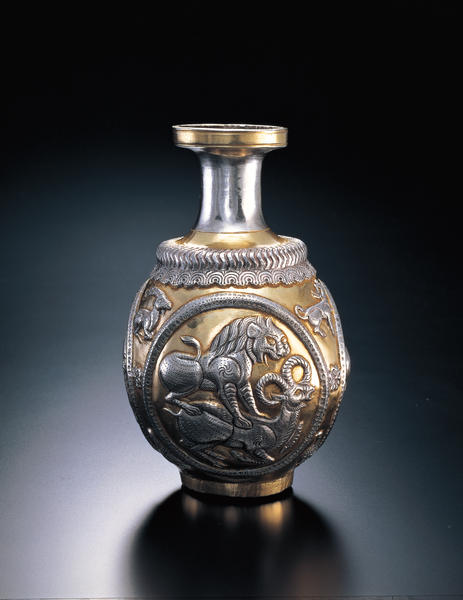Vase Decorated with Attacking Lions
- Greater Iran
- 7th - 8th century A.D.
- Silver gilt
- H-16.5 D-10
Catalogue Entry
Each of the three principle scenes on this vase--which are enclosed by medallions--portrays a lion attacking a weaker animal: an ibex, a wild sheep, or an onager (wild ass). The spaces in between are filled with a bird and a rosette, with either a rabbit, a caprid, or a dog. All of the decoration, including the distinctive collar around the shoulder of the vessel, is rendered in repouss, which is set against the gilt background.
The shape and decoration of this vessel suggest that it was produced between the fall of the Sasanian dynasty in A.D. 651 and the firm establishment, by the ninth century, of Islamic authority and culture throughout Iran and the lands to its east. Diverging somewhat from the standard Sasanian vase, this vessel has a tall, narrow neck and a spherical body, suggesting a post-Sasanian date,1 while both the subject matter and style of the animal decoration have important analogies in early Islamic art.
The lion attacking a weaker animal is a symbol of imperial authority and a well-known theme in ancient Near Eastern art but is also found in Islamic art. Perhaps the most notable and earliest Islamic example is a floor mosaic in an early Umayyad palace excavated at Khirbat al-Mafjar, near Jericho.2 Carved stucco figures of lions, caprids, and birds there are also stylistically related to the animal imagery on this silver vase, particularly the animals' wide, deep-set eyes.3 Finally, the depiction of the lion's head in nearly full-front view, as on the vase, is a characteristic of early Islamic art and is not a feature prevalent in Sasanian times.4
Small-scale silver objects such as this vase may well have influenced the decoration of architectural monuments in Umayyad Syria,5 suggesting a date for the vessel in the later seventh or early eighth century. It should be borne in mind, however, that the popularity of this type of animal imagery, as demonstrated by the palace at Khirbat al-Mafjar, may have provided a continuing motivation for the production of such silver wares, possibly for the new Muslim aristocracy.
LK
1. See Harper et al. 1978, no. 21, where a similar vase with tall neck and spherical body is dated, on account of its shape, to the seventh century.
2. Khirbat al-Mafjar is the site of a palatial complex built in the second quarter of the eighth century for a member of the first Islamic dynasty, the Umayyads (661-750): see Hamilton 1959; Ettinghausen 1972, pp. 44-47.
3. Hamilton 1959, pls. 35-38; carved stucco in architectural ornament is a means of decoration borrowed from the Sasanian world. The crowded, almost chaotic disposition of the stucco ornament from Khirbat al-Mafjar is also similar to the decoration on the Shumei vase: see Hamilton 1988, fig. 22.
4. On the full-frontal depiction of the lion's head as a dating criterion, see Harper and Meyers 1981, pp. 140-41. In the Khirbat al-Mafjar mosaic the lion's head is also depicted in a nearly full-frontal manner, though less pronounced than on the vase: see Hamilton 1959, pl. 93.
5. Grabar 1967, pp. 80-81.
